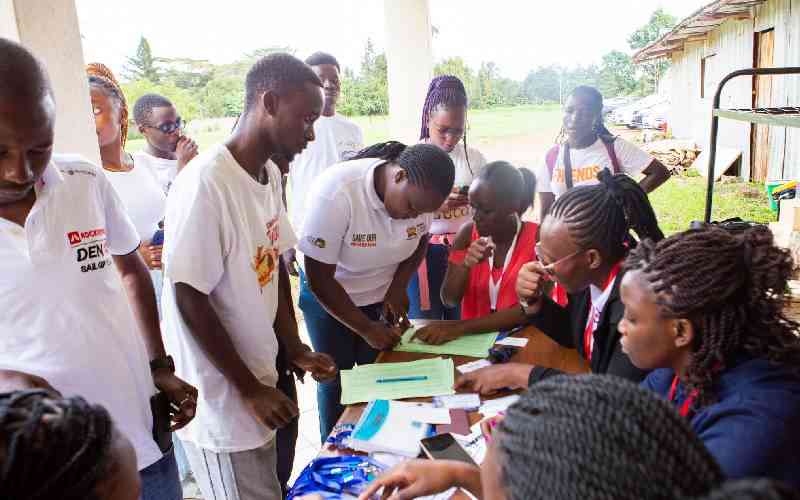A story aired by a local TV station earlier this week titled “The sins of the saviours” was harrowing beyond compare.
That a child can be stolen from the mother and “sold off” to what some consider more economically worthy parents strikes at the very core of human depravity.
While I would not wish to discuss the specific story, there are issues it raises that can be lost in the midst of what appears to be the ultimate depth of injustice.
I have been involved with children’s’ homes and at some point in my professional life even dabbled in adoption practice.
From the little I gleaned then, the story, definitely does not represent the overwhelming reality of adoption in Kenya.
First to some facts. The last time the Government issued statistics in this matter in 2015, it announced that Kenya had about 43,000 children living in charitable institutions.
Many of these children are abandoned at birth. In one children’s home I once supported in Machakos, they would occasionally find infants dropped at their gate at night.
And the managers of these homes had to depend on meagre support of well-wishers to take care of these babies. The situation is dire.
Demand for adoption
Every person recognises that the ideal environment for a child to grow up is within a family. This position has been articulated in the UN Convention on the Rights of the Child and the African Charter on the Rights of the Child.
Indeed, the movement in most countries, including Kenya is to de-institutionalise children and promote family care.
Unfortunately the demand for adoption in Kenya remains shockingly low.
In any one year, Kenya has a maximum of 400 locals applying to adopt children. That hardly scratches the surface.
Either due to custom or failure to recognise that adoption is an available option for families without children, there is little appetite for adoptions in Kenya.
In most homes there is celebration when a child finds adoptive parents. Not to discount the story that was aired on TV but it strikes me as odd that any home would go out in the informal settlements to steal babies so that it can hand them over for adoption.
Stay informed. Subscribe to our newsletter
There is already more than an adequate supply of desperate children in the system seeking adoption.
In the context of this low demand for local adoptions, it is no wonder that there was increase in international adoptions in Kenya but even before the moratorium in 2014, they were negligible.
In any year, they would hardly exceed 50 international adoptions. If there is child-trafficking, this is not where it is occurring.
One obviously recognises that where the adoption process is not stringent, things can go awry if proper vetting is not done especially for international adoptions.
Hence the 2014 moratorium to allow a review of the process so that it would not facilitate child-trafficking.
But on the whole, the majority of international adoptions were to honest well-meaning loving parents. I know one couple, who had four natural born children who adopted twin boys, went with them to the UK and returned to Kenya when the boys reached their teens so they could grow up within their Kenyan community. Such stories are legion.
Sensationalises
The problem with stories like the one that was aired is that it sensationalises what could be one unfortunate incident, whose facts need more verification, and defines all international adoptions in a negative light.
Such stories demonise charitable institutions as cartels out to steal Kenyan children, knowing full well that they will not have an opportunity to tell their side of the story.
I would, for example, have wanted to see representatives of the various institutions mentioned in that story interviewed to make the story balanced.
While they will always be some bad apples in processes of this nature, the solution is to specifically deal with them if the complaints are based on verifiable facts.
Wholesale demonisation of institutions, painting all who seek to adopt children as potential traffickers will not help the 40,000 odd children find homes. That is where our crisis is.
- The writer is an advocate of the High Court of Kenya
 The Standard Group Plc is a
multi-media organization with investments in media platforms spanning newspaper
print operations, television, radio broadcasting, digital and online services. The
Standard Group is recognized as a leading multi-media house in Kenya with a key
influence in matters of national and international interest.
The Standard Group Plc is a
multi-media organization with investments in media platforms spanning newspaper
print operations, television, radio broadcasting, digital and online services. The
Standard Group is recognized as a leading multi-media house in Kenya with a key
influence in matters of national and international interest.
 The Standard Group Plc is a
multi-media organization with investments in media platforms spanning newspaper
print operations, television, radio broadcasting, digital and online services. The
Standard Group is recognized as a leading multi-media house in Kenya with a key
influence in matters of national and international interest.
The Standard Group Plc is a
multi-media organization with investments in media platforms spanning newspaper
print operations, television, radio broadcasting, digital and online services. The
Standard Group is recognized as a leading multi-media house in Kenya with a key
influence in matters of national and international interest.








